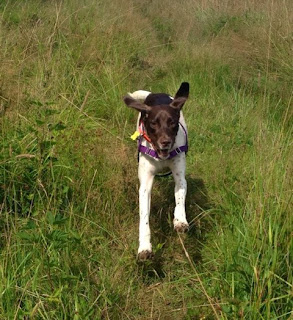Probably everyone that reads this has seen these babies. A simple contraption of a harness that has the D-Ring for attaching a leash on the front. At least, I see a lot of dogs with them on these days. Trends come and go in dog training and the tools we use to accomplish it, but right now, I am hoping this trend stays forever much like the collar, which is still great for accessorizing and attaching ID tags to, but c'mon...can you think of any other animal we put a collar on and expect to lead around on a leash? Pfft-I'll bet you can't, because it just doesn't make sense to lead animals around by the most vulnerable part to the ongoing survival of their entire body.
The second you a properly fitted collar on a dog and then put a leash on a collar, the dog's body starts trying to preserve itself by increasing blood cortisol levels and adrenaline levels. Even though the dog doesn't consciously think anything bad is happening, the autonomic parts of the brain are getting ready for survival mechanism action (i.e.: fight or flight) just like it does when we put a collar and a leash on a cat, a rabbit, a horse, a goat, or a grasshopper. These changes in the brain are why a lot of dogs start to pull like freight trains when they are wearing a collar and leash. And once they pull the adrenaline increases even more!
Many years of working with a lot of different dogs has me convinced that many dogs are adrenaline junkies, so they actually start to enjoy the whole walking on a leash, dragging a human around as much as I enjoy catching air on my mountain bike. It's just super fun and it feels great, and the more you do it, the more you want to keep doing it. A lot of dogs think of dragging their human around on a walk the same way. There is no food reward that can possibly be more valuable than the adrenaline rush the dog gets from that pressure on his throat. But if you can stop the pressure on the throat from happening, the dog will gradually lose the need to pull ahead. Dogs pull on harnesses too- there is also a reflex that causes animals to push against pressure. If you put pressure on a dog's rear end to push him into a sit position, the first thing he's going to do is push against your hand with his butt. He's not stubborn, he's just not sure what you are getting at, and his reflex is to push up against your hand. Which is why lures work so much faster than force when we teach a dog to sit.
But back to the front clip harness: If I use one of these on a dog instead of a collar, there is no pressure on the throat, or pressure on the chest to pull against. Fit is really important! The harness should fit very comfortably (but snug)and not impede the motion of the shoulders at all. There is no pressure anywhere if you fit and use a front clip harness correctly to gently simply turn the dog to face you while you make a kissy sound and take a few steps backward. After he is following you you can turn back to your original direction with him either on your left or your right side.
Of course like all behaviours we train, you needto start loose leash, connected walking in a distraction free environment and then gradually increase distractions and distance. Your job is to teach him what you want as clearly as possible, and have fun doing it and his job is to cooperate and have fun with with you. Like everything you do with your dog, learning to walk on a leash should be fun, simple and easy , it should reward both of you.
Want to learn more about training your dog using fun, easy, force free techniques? Click here!
